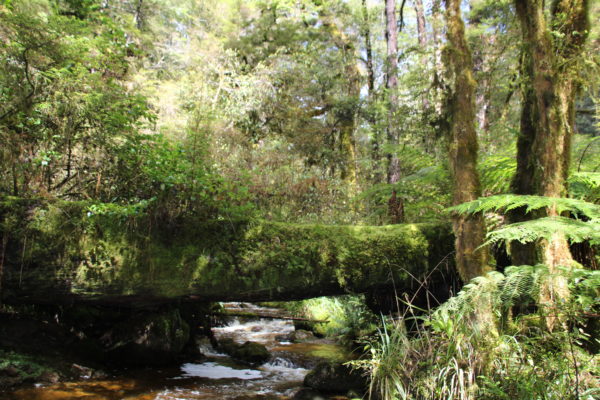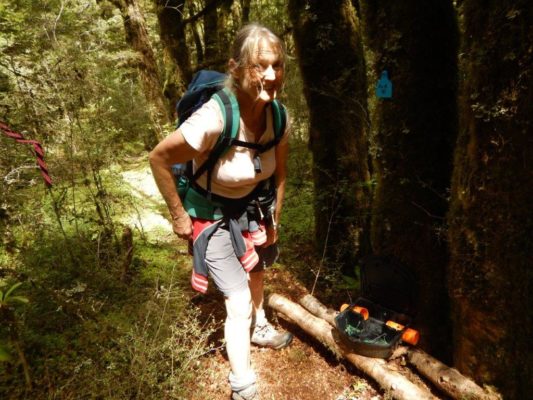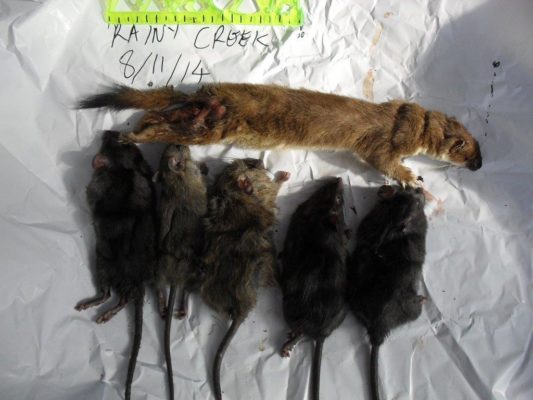Field co-ordinator, John Caygill reckons it’s “a bit of a scramble” checking the traplines on the Rainy Creek Project, “And on some lines there’s a lot of scramble!” he says.
Rainy Creek is situated just east of Reefton, on the South Island’s West Coast. John himself lives in Greymouth, an hour’s drive away, but comes up to Rainy Creek every second weekend. Most of the other 6 or 7 volunteers who are actively involved in checking traplines live locally, but two keen regulars live 1 ½ hours away. Such is the ‘pulling power’ of the forest.

“It’s a really beautiful area,” John says, “A lovely bit of bush on a nice day. It’s very peaceful, with beautiful forest.”
Currently an area of around 450 hectares is being trapped, with a 300-400m climb up each trapline. Rainy Creek volunteers need to be fit and bush savvy.
“There are around 30 traps in each line and it takes 3-5 hours to check a line,” John says. “Only one of the lines is on a properly formed track. The others are flagged with tape, so if you lose the line you could get lost very easily. It’s physically challenging terrain.”

At 450 hectares, John reckons the area is a marginal size for creating a haven and making an impact.
“We can’t eliminate predators but we’re suppressing them,” he says. “We’re catching less now, although the number of traps we have is increasing. In the future we want to expand the trapping into another part of the block.”
Currently the Rainy Creek Project has 98 DOC 200 traps along the main ridges of the Rainy Creek catchment area with 90 bait stations in between. The bait stations aren’t, however, being used currently.
“We’ve now extended the trapping with self-resetting traps,” John explains. “We’ve got 16 Goodnature A12s for possums and 45 A24 traps.”
The self-resetting traps reduce the labour requirements of the trapping regime – an important consideration when many volunteers are older, often retired people. The DOC 200 traps are checked every 3 weeks and even the Goodnature traps are checked every 6 weeks in Reefton’s hot, humid and wet climate.
“It’s a very high rainfall area,” says John. “It gets very hot in summer – 26-28 degrees celcius – so the lures get mouldy very quickly. We find we get most of our catches in the first few weeks. We change the gas every 18 weeks too, because the cylinders can corrode around the thread in the humidity.”

The group uses Erayz rabbit meat and catches mainly rats and some stoats – “quite a few stoats at some times of the year,” says John.
The Rainy Creek Project is managed by local Forest and Bird members and other local volunteers who took over the restoration work from gold-mining company, Oceania Gold.
“Oceania Gold had a big mine on the hill and there was a condition in the mining agreement that they carry out pest control below the mine,” John explains. “They had an agreement with DOC for several years, but the pest control ceased in 2008 and the money went elsewhere. They pulled out most of the equipment too. So West Coast Forest & Bird took it on, got a grant and set up trap lines. It was a chance for Forest & Bird to do something positive in our community.”
Others from Reefton were also keen to be involved and the project has evolved from there.
“It’s good bush in the foothills of the Victoria Ranges,” says John, “with red beech, hard beech, kamahi, rimu and other podocarps on the lower slopes and mountain beech, southern rata, kamahi, rimu and areas of manuka and pink pine (Halocarpus biformis) on the higher slopes.”
Intriguingly, the middle block of Rainy Creek was the site of the last reported South Island kokako sighting.
“Two or three years ago, Gerald, the previous field co-ordinator, saw a possible kokako,” says John. “I was with him, behind him, but didn’t see it. However, some months later, on a nearby line, I heard an unmistakeably kokako-like call. It was very distinctive, different.”
Not everyone was convinced it was an actual kokako however.
“An expert thought I’d heard a tui calling. He reckoned tui had heard the kokako calling in the past, learnt the call and passed it on to later generations of tui.”
John admits the expert’s explanation has some merit.
“A couple of local volunteers who are very knowledgeable were on a break and thought they heard a kaka song. They looked up at the bird and there was a tui mimicking the kaka song beautifully.”
So could the South Island kokako be making its last stand at Rainy Creek, near Reefton? No-one knows one way or the other, but it’s another good reason for keeping on top of those rats, possums and stoats.

